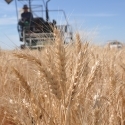27 Jul 2015
Nutrient Use Efficiency on Grain Farms
A GRDC Supported project

Water use efficiency is widely recognised as a key performance indicator for crop production. Similarly NUTIRENT USE EFFICIENCY (NUE) for nitrogen, phosphorus, potassium and sulphur can indicate resource use effectiveness and economic performance of these important crop input.
Why measure NUE?
Fertilizer is frequently the biggest single cost for cropping. With slim margins, it is important to achieve the best possible return on money invested in fertiliser.
There is also international interest is assessing nutrient use efficiency to first measure this and then look for strategies to improve efficiency, while maintain productivity and food security.
Efficiency can best be measured over a number of seasons as the input and output of nutrients at a field or farm scale. In Australia, while national figures for the grains industry can be estimated (Table 1) there are no reliable at state or regional level, and this project aims to fill that gap by collecting farm/field level measurements fertilizer use, grain or other material produces, along with an estimate of legume N input, These data will be collected, collated and provided back to the industry.
Developing strategies to improve NUE has two broad outcomes;
- 1. Achieving a higher crop yield on the N supplied (Partial Factor Productivity)
2. Assessment of the effect of management on the balance of N in the field or farm (Partial Nutrient Balance).
| Country 1 | Average N rate (kgN/ha) | Partial Factor Productivity
(kg grain/kg N) | Partial Nutrient Balance
(kg N/kg N) |
Australia | 30 | 50 | 1.07 |
Argentina | 61 | 41 | 1.30 |
Brazil | 35 | 65 | 1.28 |
China | 202 | 23 | 0.54 |
India | 113 | 25 | 0.47 |
USA | 71 | 41 | 0.73 |
EU | 105 | 51 | 0.96 |
For more information see: http://anz.ipni.net/article/ANZ-3222
Additional Resources
Nutrient Performance IndicatorsSize: 1.15 MB




